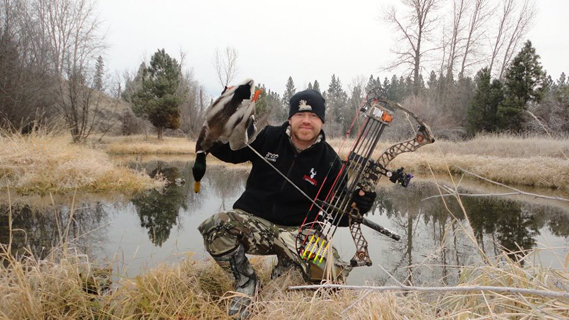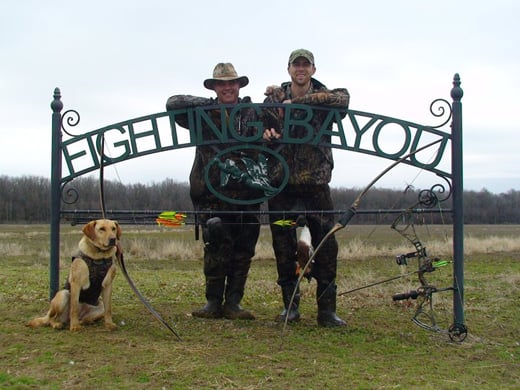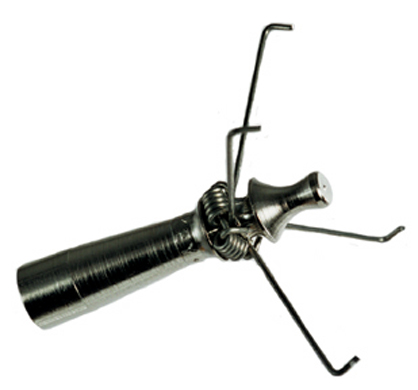LAST UPDATED: May 1st, 2015
Written by Bowhunting.com contributor Brodie Swisher.
When it comes to hunting with my bow I love a good challenge. Big game or small….I love to simply shoot critters with an arrow. Several years ago my buddy, Kevin Drewry, of Fathers in the Field (fathersinthefield.com), and I began to talk about a new challenge – hunting ducks with a bow. Kevin was a waterfowl guide at the time and was always eager to try something different after a long season of guiding clients. Deer season had passed and we longed for more days in the field with our bows. I’d seen guys successfully hunt geese with a bow, but had found very little on ducks being hunted with a bow. So a new challenge began to unfold. We wouldn’t sit and watch the months of winter slowly pass without taking part in a fresh new challenge….duck hunting with a bow!

Looking for a new bowhunting challenge? Try arrowing a duck!
Typically, duck hunters and deer hunters are two unique breeds. I know a number of duck hunters that hunt strictly for feathered fowl. They never set foot in the deer woods. And there are countless big game bowhunters that don’t give a rip about shotgunning ducks. But when a hybrid hunting challenge unfolds, the best of both worlds come to light. And with waterfowl seasons typically running through mid-to-late January, it just might be the perfect challenge to help keep you bowhunting through the lack-luster months of winter.
The Setup
The “hide” for most waterfowlers consists of a brushed, box-style blind or pit-style blind in open fields. While this works for the shotgun toting hunter, it is not conducive for the bowhunter. Bow limbs and arrow shafts require a little more room to roam as the shot opportunity arrives. Therefore, special arrangements must be made to accommodate the archer.
Total concealment is the name of the game. However, be sure your blind of choice offers enough room to manuever your bow for the shot; which could come from any number of directions.
One method that can cross over from shotgun hunter to the bow hunter, particularly for archers attempting to shoot ducks on the wing, is to hide behind large diameter trees and thick brush in flooded timber. However, this rarely seems to work when attempting to let ducks light on the water before shooting. The incredibly sharp eyes of ducks will seldom tolerate the movement of coming to full draw without exploding away from the scene. In my opinion, complete concealment is a must for shooting ducks at close range on the water. For this reason, I employ the Primos Double Bull blind (primos.com) for total concealment when coming to full draw on super-close ducks.
As with any critter, the best setup will come when setting up your hide where ducks are already naturally using a location for feeding, resting, roosting (I don’t encourage shooting the roost), etc. When you attempt to call a critter out of their routine they tend to be more guarded and scrutinize the setup more on the approach. Backwater pockets, small sloughs, or ponds are ideal sets for getting ducks in range. The key is to find small enough pockets of water that concentrate ducks to within your effective range. You can set up on a 5-acre pond, but chances are, ducks will hit the water far outside of bow-range. Look for beaver ponds and warm-water sloughs that typically hold lots of ducks, and due to their smaller size, keep ducks within effective striking distance.
If you decide to go with an outfitter in your quest for bowhunting ducks, be sure to pick one that is familiar with the unique difficulties that accompany such a task.
Despite its small-sized brain, a duck is an incredibly wary game bird. Their keen eyesight routinely picks out the most minimal movement and anything on the landscape that looks out of place. Take some time to ensure that your ground blind blends well with the surrounding area. Use limbs, brush, or grass to breakup roof outlines and corners. You want the look of brush, not a box. Also, be sure to wear black when inside a black-backed ground blind. Unlike camo, a black coat, gloves, and mask will eliminate the flash from within the blind that easily spooks ducks from the water. Sure, you’ll feel like a ninja sitting there waiting on ducks. But when you go ninja, you go undetected. I’ve even taken this a step further by hunting with a black-finished bow. My black Mathews Helim Tactical (mathewsinc.com) has even allowed me to draw on sharp-eyed deer and turkeys looking right in the window of my blind at 8 yards and less. Black is best when hunting in the ground blind!
Gear for Ducks
I prefer to hunt with the same bow setup for small game as I would for big game. Some hunters may crank their draw weight down enabling them to draw and hold easier and longer. However, I like the practice and muscle-building of shooting the same setup throughout the season. Unlike shooting squirrels and other small game, I prefer a small profile broadhead for ducks as opposed to a judo-tipped arrow. Ducks can take a lick and keep on trucking. A broadhead will typically anchor that bird on the water.
The author prefers standard broadheads over popular “small game” heads that are commonly used.
The setup my buddy, Kevin, prefers is an adder point behind a field point. “When hunting with a traditional bow, and attempting to take shots at ducks in the air, I like flu-flu arrows with an adder-backed field tip. Otherwise I use my regular compound bow setup for “skillet shooting” (shooting ducks on the water), with the adder and field point combination. It’s a great setup,” says Drewry. Depending on the depth of the water, waders or hip-boots may be necessary. With broadheads in play, it is not safe for a retriever dog to be in the mix. You’ll be retrieving your own birds and fishing for arrows. Be sure to have the boots or waders to keep you dry. Add a small heater to the mix when hunting the frigid temps of winter, and you’ll stay toasty and warm within the ground blind.
Decoys
When hunting smaller pockets of water for ducks, large decoy spreads are not necessary. In fact, decoys may hinder ducks landing exactly where you need them, or even cause ducks to spook prior to shot opportunities happening. I simply use a couple decoys to pull ducks past my blind as they swim in front of my setup. Again, if you’re intentions are to shoot ducks on the wing, your decoy spread may be similar to a close-range setup used when shotgun hunting for ducks. The key is to get the ducks close. And when hunting with a bow, close is rarely close enough!
Unlike hunting ducks with a shotgun, less is often more when archery tackle is employed.
Want a new bowhunting challenge that lingers well into the new year? Try bowhunting for ducks! You’ll test your shooting skills, build confidence, and develop your endurance for long wintertime hours outdoors. And you just might find a new bowhunting addiction that you return to with each passing winter.







